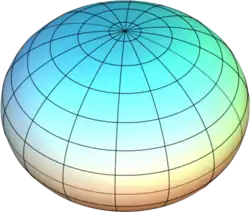参考椭球
在大地测量学中, 参考椭球是一个数学上定义的地球表面,它近似于大地水准面。 由于其相对简单,参考椭球是大地控制网计算和显示点坐标(如纬度,经度和海拔)的首选的地球表面的几何模型。通常所说地球的形状和大小,实际上就是以参考椭球的长半轴、短半轴和扁率来表示的。

平顶球
| 大地测量学 |
|---|
 |
常用的地球参考椭球
目前最常用的参考椭球,是美国国防部制图局(DMA)在1984年构建的WGS84。
下表列出了一些最常见的参考椭球:
| 椭球名称 | 长半轴 (米) | 短半轴 (米) | 扁率的倒數, | 使用的国家和地区 |
|---|---|---|---|---|
| 克拉克(Clarke)1866 | 6 378 206.4 | 6 356 583.8 | 294.978 698 2 | 北美 |
| 克拉克(Clarke)1880 | 6 378 245 | 6 356 510 | 293.46 | 北美 |
| 白塞尔(Bessel)1841 | 6 377 397.155 | 6 356 078.965 | 299.152 843 4 | 日本及台湾 |
| International 1924 | 6 378 388 | 6 356 911.9 | 296.999 362 1 | 欧洲、北美及中东 |
| 克拉索夫斯基(Krasovsky)1940 | 6 378 245 | 6 356 863 | 298.299 738 1 | 俄罗斯、中国 |
| 1975年国际会议推荐的参考椭球 | 6 378 140 | 6 356 755 | 298.257 | 中国 |
| GRS 1980 | 6 378 137 | 6 356 752.3141 | 298.257 222 101 | |
| WGS 1984 | 6 378 137 | 6 356 752.3142 | 298.257 223 563 | 全球 |
| Sphere(6371 km) | 6 371 000 | 6 371 000 |
大陆地区在1954年前曾采用International 1924参考椭球,之后较长一段时间内采用基于克拉索夫斯基(Krasovsky)1940的1954年北京坐标系。1980年开始使用1975年国际大地测量与地球物理联合会第16届大会推荐的参考椭球。 [1]
参考文献
- P. K. Seidelmann (Chair), et al. (2005),“Report Of The IAU/IAG Working Group On Cartographic Coordinates And Rotational Elements: 2003,”Celestial Mechanics and Dynamical Astronomy, 91, pp. 203-215.
- OpenGIS Implementation Specification for Geographic information - Simple feature access - Part 1: Common architecture, Annex B.4. 2005-11-30
- Web address: http://www.opengeospatial.org(页面存档备份,存于)
- 惯性导航原理,陈永冰等,国防工业出版社. ISBN 978-7-118-05399-9. P17
This article is issued from Wikipedia. The text is licensed under Creative Commons - Attribution - Sharealike. Additional terms may apply for the media files.